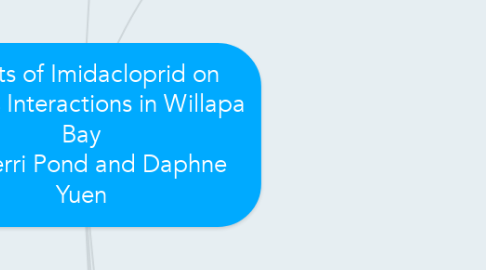
1. Background
1.1. Framing Question
1.1.1. To what extent should policy makers consider the effects of pesticides on entire ecosystems when making decisions regarding aquatic pesticide use?
1.2. Ecosystem health/diversity
1.2.1. Kim Patten's argument for spraying imidacloprid; spraying = greater biodiversity
1.2.2. Ecosystem Health and its relation to ecological policies, societal values, misuse of the word and scientific assumptions
1.2.3. The Value of Ecosystem Health
1.3. Aquaculture
1.3.1. NOAA - What is aquaculture?
1.4. Bioaccumulation
1.4.1. Bioamplification, Bioaccumulation and Bioconcentration
1.5. Imidacloprid
1.5.1. Levels of impact on various species
1.5.2. Pesticide Information Project
2. Situated Context
2.1. Focus Questions
2.1.1. To what extent should the policy makers consider the effects of imidacloprid on other species in the Willapa Bay ecosystem, such as the honey bee population?
2.1.2. With the current understanding of the effects of imidaclopird on other species, should policy makers allow WGHOGA oyster growers to spray imidacloprid on their mudflats to control the burrowing shrimp population?
2.2. Stakeholders/Non-Oyster Beings
2.2.1. Oyster Farms/Farmers
2.2.1.1. pro-spray
2.2.2. Environmental Advocates
2.2.2.1. anti-spray
2.2.3. Restaurant Owners
2.2.3.1. anti-spray
2.3. Willapa Bay
2.3.1. Oysters
2.3.1.1. The Pacific Oyster (native to Japan) was introduced to Willapa Bay during the 1920s after the economic boom and bust of the Olympia oyster that is native to Willapa Bay.
2.3.1.2. The Pacific Oyster became the predominantly farmed oyster by mid 20th Century.
2.3.1.3. Nowadays, the majority of Pacific Oysters are shipped outside of the U.S., where there is larger market for canned oysters.
2.3.1.4. Oyster growers want to be able to spray their mudflats with imidacloprid in order to control the burrowing shrimp population, which they argue destabilizes mudflats, ultimately causing oysters to sink and suffocate.
2.3.2. Imidacloprid Spraying Permit/Methods of spraying
2.3.2.1. Imidacloprid
2.3.2.1.1. "Imidacloprid has the ability to bind to sediments" (Felsot and Ruppert 2002; Grue and Grassley 2013). From EIS.
2.3.2.1.2. "Imidacloprid is an insecticide that was made to mimic nicotine. Nicotine is naturally found in many plants, including tobacco, and is toxic to insects. Imidacloprid is used to control sucking insects, termites, some soil insects, and fleas on pets. It has been used in products sold in the United States since 1994." (National Pesticide Information Center, Sponsered by OSU?)
2.3.2.1.3. Risk Assessment of Imidacloprid
2.3.2.2. "WGHOGA has requested issuance of a NPDES permit for the purpose of allowing chemical applications of imidacloprid on up to 2,000 acres per year of commercial shellfish beds: approximately up to 1,500 acres per year within Willapa Bay, and up to 500 acres per year within Grays Harbor" (EIS, 2015).
2.3.2.3. Imidacloprid Spraying Permit
2.3.2.3.1. Approved
2.3.2.3.2. Removed
2.3.2.3.3. Re-issue/re-approval
2.3.2.4. Public Perceptions/Sentiments towards Imidacloprid
2.3.2.4.1. Public sentiment/perceptions have had a significant effect on the use of imidacloprid; some argue that because it's being sprayed within the system, it now becomes part of the system creating issues with species and ecosystem health.
2.3.3. Honey Bees
2.3.3.1. Honey Bees and Imidacloprid
2.3.3.1.1. Imidacloprid and its relation to bioaccumulation within the ecosystem
2.3.3.1.2. A significant amount of research about the relationship between imidacloprid and honeybees has been done. A strong correlation between imidacloprid and negative effects on honey bee behavior. These findings have predominantly looked at these three variables:
2.3.3.1.3. The method in which imidacloprid is being sprayed can have a significant impact on the honey bee population (i.e. airborne, how is actually getting on the mudflats)
2.3.3.2. Honey Bees are an important pollinator in Willapa Bay
2.3.3.2.1. There has been a correlation to the spraying of imidacloprid and the collapse of bee populations.
2.3.3.2.2. Some stakeholders are concerned the population could suffer major declines due to the highly publicized and fairly good correlation that has been made by scientists that imidacloprid can cause colony collapse disorder
3. Broader Implications
3.1. Further research
3.1.1. into field-realistic lethal doses
3.1.1.1. Shown to have high variability
3.1.2. Neonicontinoids effects on Aquatic Invertebrates
3.1.3. Neonicontinoids effects on other no targeted species i.e. mammals and other invertebrates
3.2. Applications to other situated contexts
3.2.1. East Coast Estuaries and Farms
3.2.2. International contexts i.e. Hong Kong, Japan
3.2.3. How do attitudes towards imidacloprid relate to attitudes towards other pesticides, neonicontinoids, etc
